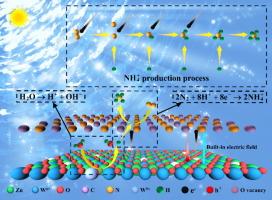Highly efficient photocatalytic nitrogen fixation of ZnWO4/g-C3N4 S-scheme heterojunction nanofibers: Synergistic effect of water molecules deprotonation and photogenerated electrons
IF 6.3
2区 材料科学
Q2 CHEMISTRY, PHYSICAL
引用次数: 0
Abstract
Photocatalytic nitrogen fixation presents a promising method for low-energy and environmentally friendly ammonia production. However, efficiency remains relatively low due to insufficient proton and electron supply during the photocatalytic process. In this study, ZnWO4/g-C3N4 S-scheme heterojunction nanofibers are prepared by electrospinning combined with vapor deposition method. The ZnWO4/g-C3N4 nanofibers are rich in oxygen vacancies and heterovalent W ions, which work synergistically to protonate water molecules, thereby providing the necessary protons for nitrogen fixation. The matched energy band structures of ZnWO4 and g-C3N4 form a internal electric field at contact interface, which effectively separate photogenerated carriers. The one-dimensional nanofiber structure induces the carrier transport along the fiber axis and shortens the diffuse distance for carriers to active sites. As expected, the maximum photocatalytic nitrogen fixation performance of ZnWO4/g-C3N4 reaches 144.5 μmol·L-1·min−1·g−1, which is 19.5 times higher than that of single-component g-C3N4. After five cycles of experiments, the performance is 90.8 % of the original, showing significant stability. ZnWO4/g-C3N4 also exhibits excellent photocatalytic nitrogen fixation activity and stability in natural river water, with practical application potential. This innovative achievement is expected to be applied in future agricultural production, promoting agriculture towards a greener and lower-carbon direction.


ZnWO4/g-C3N4 s型异质结纳米纤维的高效光催化固氮:水分子脱质子和光生电子的协同效应
光催化固氮是一种很有前途的低能耗、环保制氨方法。然而,由于光催化过程中质子和电子供应不足,效率仍然相对较低。本研究采用静电纺丝和气相沉积相结合的方法制备了ZnWO4/g-C3N4 S-scheme异质结纳米纤维。ZnWO4/g-C3N4纳米纤维富含氧空位和异价W离子,它们协同作用使水分子质子化,从而为固氮提供必需的质子。ZnWO4和g-C3N4的匹配能带结构在接触界面形成内置电场,有效地分离光生载流子。一维纳米纤维结构诱导了载流子沿纤维轴的传输,缩短了载流子到活性位点的扩散距离。ZnWO4/g- c3n4的最大光催化固氮性能达到144.5 μmol·L-1·min−1·g−1,是单组分g- c3n4的19.5倍。经过5次循环实验,性能为原来的90.8 %,稳定性显著。ZnWO4/g-C3N4在天然河水中也表现出良好的光催化固氮活性和稳定性,具有实际应用潜力。这一创新成果有望应用于未来的农业生产,推动农业朝着更绿色、更低碳的方向发展。
本文章由计算机程序翻译,如有差异,请以英文原文为准。
求助全文
约1分钟内获得全文
求助全文
来源期刊

Applied Surface Science
工程技术-材料科学:膜
CiteScore
12.50
自引率
7.50%
发文量
3393
审稿时长
67 days
期刊介绍:
Applied Surface Science covers topics contributing to a better understanding of surfaces, interfaces, nanostructures and their applications. The journal is concerned with scientific research on the atomic and molecular level of material properties determined with specific surface analytical techniques and/or computational methods, as well as the processing of such structures.
文献相关原料
公司名称
产品信息
阿拉丁
Polyvinylpyrrolidone
 求助内容:
求助内容: 应助结果提醒方式:
应助结果提醒方式:


